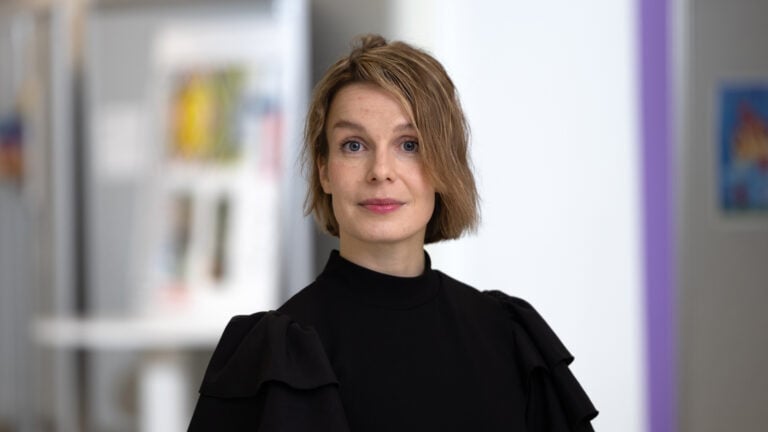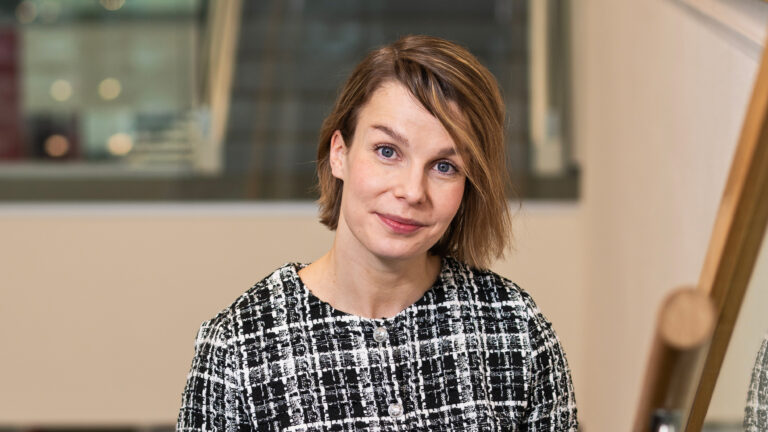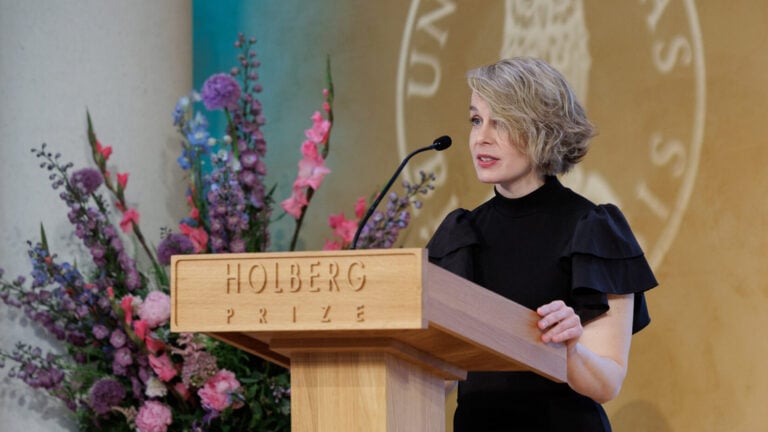Den 3. juni holdt Daniela Daniela Alaattinoğlu sin Nils Klim-forelesning i Universitetsaulaen i Bergen. Forelesningen gjengis her i sin helhet på engelsk.
Hvordan kan erfaringer som ofte er marginalisert i juridiske diskusjoner, styrke aktuelle beskrivelser av rettighetsutvikling i Norden?
Daniela Alaattinoğlu holdt sin Nils Klim-forelesning som åpninginnlegg under Nils Klim-symposiet: ‘Nordic Right Development from the Margins? Reassessing Legal Inclusion and Exclusion ’ , som fant sted i Universitetsaulaen i Bergen 3. juni 2025.
Nordic Rights Development from the Margins? Reassessing Legal Inclusion and Exclusion
The Nordic countries—Norway, Sweden, Finland, Denmark and Iceland—are often seen as progressive societies. These states frequently present themselves as global leaders in human development and as defenders of human rights.
Yet, if we look more closely at the legal cultures of these nations, something striking appears: for a long time, rights were largely viewed not as binding legal tools, but as abstract ideals—guiding principles for public institutions rather than enforceable claims that individuals or groups could use to challenge laws or state practices.
After all, the Nordic countries are places where parliamentary power has traditionally taken precedence and where there has been scepticism toward substantial judicial review. In the Nordics, lawyers have traditionally been imagined as professionals with technical knowledge of how the state machinery operates, rather than people who question the premises and functions of the state machine.
At times, the phrase Nordic rights revolution is used to describe a visible shift: a growing role for law and rights in public life, and a more active use of legal tools by individuals and groups to contest policies and seek change. In an increasingly international legal environment, judicial review has become more accepted across the region and is now used more actively by civil society.
This narrative—of progress, of opening—has gained wide acceptance. It also forms a key backdrop for much of my own work. But it is a narrative that tends to centre elite legal actors, venues and specific rights—such as the right to property.
In this symposium, I want to shift focus. I want to draw attention to three recent cases where people have used legal means to challenge systemic oppression as rights violations. What unites these examples is that they are rarely seen as central to Nordic legal development. More often, they are treated as isolated stories—telling us something about the groups involved, rather than offering insight into the legal systems and the broader role of law in our societies.
But what if we looked at them differently? What if, instead of treating these cases as marginal, we asked: What do they reveal about the nature and direction of Nordic rights development?
Rights issues and rights violations
The first lesson, I suggest, is this: some issues have required extraordinary efforts—mobilisation, campaigning, legal advocacy—simply to be recognised as rights issues, and their harms as rights violations.
The example I would like to begin with is the use of sterilisation and castration policies targeting trans people.
At birth, we are all assigned a legal gender—primarily based on the appearance of our genitals. Understandably, not everyone identifies with the gender assigned to them. Legal gender recognition—the possibility to amend one’s official gender—has been introduced in several countries since the 1970s. Sweden was the first, in 1972. But it came with preconditions—most notably, a requirement of infertility.
In other words, to legally amend their gender, trans people in Sweden had to be sterilised. The stated aim was to ‘eliminate the risk of confusion in family relations’ and to ensure that ‘a person registered as male does not become a mother, and one registered as female does not become a father’.
This model influenced many other countries. Infertility requirements were introduced with the assumption that all trans people wanted the same set of medical and surgical interventions—and that society’s interest in a rigid gender order justified overriding trans people’s reproductive rights. Often, these laws and practices were established without even consulting those most concerned: trans people themselves.
Since the late 2000s, these policies have increasingly been challenged—through strategic litigation, public campaigns, international advocacy and grassroots mobilisation. Still, in a world shaped by cisnormativity—the assumption that people identify with the gender they were assigned at birth—it remains a major struggle to establish gender identity as a legal right.
A right that cannot be made conditional on surgery, sterilisation, or the removal of reproductive organs. A right whose violation requires acknowledgment—and reparations.
To this day, legal gender recognition based on self-identification remains contested in many places. Furthermore, very few countries have followed Sweden’s lead in offering compensation to those who were sterilised under earlier regulations—people who still live with the effects of these irreversible procedures.
In the words of one of the litigants who challenged the previous Norwegian policy before the courts:
The fact that I can’t have children is something that will stay with me for the rest of my life.[i]
This example—of sterilisation practices and the long, strategic efforts needed to contest them—illustrates my first point: that some claims are more readily recognised as rights, and some harms more easily accepted as rights violations, than others.
Rightsholdership is deeply contextual
The second lesson I would like to highlight in the development of Nordic rights is this: rights depend not only on their formal recognition, but also on who is seen as entitled to hold them. In other words, rightsholdership is deeply contextual.
A striking example of this is the forced reproductive control of Greenlandic women.
In recent years, Greenland—a self-governing territory within the Kingdom of Denmark—has been back in international headlines. These headlines remind us that colonialism is not merely a relic of the past. They also point to a practice that has only recently received the attention it demands: the systematic insertion of intrauterine contraceptive devices (IUDs) into the bodies of Greenlandic women and girls, most of whom are Indigenous Inuit.
Often, these procedures were carried out without the consent—or even the knowledge—of the women themselves or their parents.
These widespread and state-sanctioned oppressive interventions were designed to limit the reproduction of Greenlandic women, mainly in the latter half of the 20th century, though reports of such practices continue to emerge. Today, the issue is under public investigation.
So far, 143 women directly affected by these procedures have brought legal action, demanding reparations from the Danish state. Their claims point to long-lasting harms: fertility problems, chronic pain and trauma.
In the words of one survivor:
I was not allowed to rule over my own body or my uterus. I feel as if my body was colonized. Today, I have taken back my authority through my protests. I have decolonized my body, but I have no doubt that our bodies were colonized back then. It is only now that my body and my psyche no longer belong to the government.[ii]
This case reveals a profound contradiction.
While reproductive rights have, on paper, been strengthened across the Nordic region—especially through reforms in abortion and sterilisation laws in the 1960s and 1970s that emphasised individual choice, gender equality and bodily autonomy—these rights have not been experienced equally by all.
What is often imagined as a universal framework has, in practice, come with exclusions. The principle of universality itself is tested when we see that some bodies, some lives, are treated as less worthy of rights protection than others.
As one of the Greenlandic women stated, It is only now that my body and my psyche no longer belong to the government. That sentence alone forces us to question the integrity of the human rights narrative in the Nordic context.
The example of forced reproductive control also shows us that public debate over who should reproduce—and who should not—is not just a dark chapter from the past. These conversations are still ongoing and their harms enduring, shaped by historical inequalities and current power structures.
Therefore, the second lesson is this: our narratives of rights development in the Nordics must take much more seriously the question of who is granted the status of rightsholder. And these exclusions—these exceptions to the supposed rule—need far more critical scrutiny than they often receive.
On Justiciability
The third lesson I would like to highlight concerns justiciability—the extent to which rights can be meaningfully enforced through the courts.
In the Nordic countries, courts have traditionally exercised restraint when it comes to judicial review. But this is not just a matter of institutional deference. It is also a question of which rights are seen as suitable for legal adjudication in the first place. Not all rights are treated equally.
A clear example of this is the ongoing struggle over land rights for the Indigenous Sámi people in Norway, Sweden and Finland.
Reindeer herding, a traditional Sámi livelihood, has long been regulated by Nordic settler states within Sápmi—the Sámi people’s ancestral territory. In Sweden, for instance, it is telling that the rights of reindeer herders were historically not recognised as rights at all, but as privileges. That legal status—granted at the discretion of the state—implied it could also be withdrawn at will.[iii]
In recent decades, international legal developments and the Nordic states’ growing engagement with supranational organisations have contributed – at least partly – to a formal, de jure recognition of the Sámi as Indigenous peoples. This recognition implies certain rights—including land rights.
But this shift in formal status has not always translated into de facto changes on the ground. Land use in the Nordic countries remains highly contested, and the everyday realities for Sámi communities often remain unchanged.
That said, Sámi organisations and litigants have increasingly turned to law—especially through strategic litigation and engagement with human rights bodies—to challenge these conditions. In doing so, they have contributed to a growing justiciability of Indigenous land rights.
Landmark legal victories, such as the Girjas case in Sweden and the Fosen case in Norway, have established important precedents. But the aftermath of these decisions also raises another critical point: even when rights violations are formally recognised, the remedies offered may be limited.
This gap between legal recognition and material redress calls into question how the harms experienced by the Sámi people are understood—and how seriously those harms are taken in efforts to prevent them from recurring.
In the words of the President of the Sámi Parliament in Finland, speaking of recent decisions from United Nations Treaty Bodies:
I think these cases and the decisions really shed light to the very basic things that we have always known: that Indigenous peoples have inherent rights. We’ve always had them. We will have them after the nation-states fail, and we have to remember that we have to defend those rights, court by court and case by case, and show the world that these rights are real and that there are certain processes that need to be respected.[iv]
So, the third lesson is this: the legal recognition of rights is not enough. When certain rights are pushed to the margins—sometimes dismissed as ‘third-generation’ rights—they are often treated as less urgent, less enforceable. This hierarchy of rights is also visible in the Nordic context and limits the scope of meaningful rights development.
Nordic rights development seen from the margins
So, what can we learn when we study Nordic rights development from the margins?
Today, I have drawn on three examples to highlight elements of rights that deserve more sustained attention—not just as the concerns of a few, but as core legal questions: the situated nature of rights and rights violations, the contextual dynamics of rightsholdership and the changing justiciability of rights.
In all of these examples, we see how law has been used to classify and govern groups—often with the state defining who belongs to which category and what that belonging entails. At the same time, we see how civil society actors have mobilised the law to contest exclusionary policies, to seek recognition and to demand justice.
The cases I have discussed also remind us that, in practice, rights are often not as universal as we imagine. They are shaped by context, distributed unevenly, and subject to hierarchies—rather than truly inherent, indivisible and non-discriminatory.
While the Nordic countries may think of themselves as moral superpowers—as exceptional in our commitment to equality and justice—these challenges are not unique to our region. The questions of which issues are seen as legally relevant and whose experiences count as rights violations are fundamental everywhere.
I would like to end by inviting the panel—composed of experts who have each, in their own way, expanded the boundaries of what law, legal inquiry and rights can encompass—to reflect on these themes.
Some questions I would like to pose are:
- How can we better account for contextual and contested rightsholdership?
- What role should legal scholars and practitioners play in recognising and amplifying rights claims that emerge from outside traditional legal spaces?
- How might interdisciplinary perspectives, especially from anthropology, the broader social sciences and humanities, help reframe what we consider a legal issue—and who we see as legitimate legal actors?
I look forward to your reflections.
Notes
[i] Rosef, Krever kompensasjon for steriliserte transpersoner: – En umenneskelig praksis, VG (2020),www.vg.no/nyheter/i/awmz8O/krever-kompensasjon-for-steriliserte-transpersoner-en-umenneskelig-praksis.
[ii] Breum, Greenland women seek a reckoning for a 1960s Danish campaign to reduce births in Greenland (2023), www.martinbreum.dk/greenland-women-seek-a-reckoning-for-a-1960s-danish-campaign-to-reduce-births-in-greenland/.
[iii] This is perhaps most clearly shown in Mörkenstam, Om “Lapparnes privilegier”: föreställningar om samiskhet i svensk samepolitik 1883-1997. Stockholm University, PhD thesis (1999).
[iv] Ahtone, UN report backs up Sámi claims that mining in Finland violates their rights to land and culture, Grist(2024), https://grist.org/global-indigenous-affairs-desk/un-backs-sami-fight-over-land-finland/.
Sist endret:
Publisert:
Fakta
Daniela Alaattinoğlu mottok Nils Klim-prisen i 2025. Alaattinoğlu er første-amanuensis i rettsvitenskap ved Åbo universitet (University of Turku). Hun leder prosjektet From the Margin to the Centre: Rights Development, Transitional Justice and Indigeneity in the Nordics (MARCEN), finansiert av Det europeiske forskningsrådet (Starting Grant, 2025–2029). Hennes forskning har mottatt støtte fra blant annet Islands forskningsfond (2020–2023), den Svenska kulturfonden i Finland (2020–2022) og Finlands Akademi (2014–2019). Alaattinoğlu er også medredaktør for Retfærd: The Nordic Journal of Law and Justice og medgrunnlegger av forskningsmiljøet Law, Space and Justice ved Åbo universitet.
Relatert innhold

Daniela Alaattinoğlu
Nils Klim-prisen 2025 er tildelt den finske juristen Daniela Alaattinoğlu.

Nils Klim-symposiet 2025: “Nordic Rights Development from the Margins? Reassessing Legal Inclusion and Exclusion.”
Hvordan kan erfaringer som ofte er marginalisert i juridiske diskusjoner, styrke aktuelle beskrivelser av rettighetsutvikling i Norden?

Nils Klim-prisvinnerens takketale
Den 5. juni ble Nils Klim-prisen overrakt Daniela Alaattinoğlu. Hennes takketale gjengid her i sin helhet.
